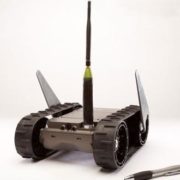 Recently the ARMY announced the cancellation of its current contract for the Joint Tactical Radio System (JTRS) Ground Mobile Radio System. Did its highly publicized plans for a battlefield smartphone have something to it?
Recently the ARMY announced the cancellation of its current contract for the Joint Tactical Radio System (JTRS) Ground Mobile Radio System. Did its highly publicized plans for a battlefield smartphone have something to it?
An uniformed person might think, “Sure, what does the ARMY need JTRS for, when they’re going for a smartphone?” Actually, the smartphone’s success depends on JTRS.
While security is usually described as the Number 1 concern for the battlefield phone, the lack of cellular service in potential combat zones has emerged as a major obstacle (Razorianfly). Almost all the proposed solutions for dealing with connectivity are partial. Some of the more innovative solutions include installing cellular equipment on blimps, UAVs, and aerostats. There’s even talk of a “cell tower in a suitcase.”
However, currently, the most practical idea is sending out a vehicle, such as a Humvee with a collapsible cellular tower. This has obvious limitations. The Humvee is a tempting target for the enemy, and its footprint would be limited.
Another partial solution is employing WiFi connectivity. This has the advantage of enabling MESH networks, which expand the footprint by allowing each communication device to become a relay node. Of course, as anyone who’s used a wireless connection on their portable computer can tell you, this form of connectivity is not without its problems.
Another partial solution is connecting the smartphone to the JTRS. This establishes Line Of Sight (LOS) communication, and also takes advantage of the latter’s superior encryption capabilities.
Probably the battlefield of the near future will employ a mix of WiFi, cellular service, and JTRS. JTRS is a critical element in this mix. While the ARMY is pulling out all stops to deploy smartphones, it has no intention of abandoning the JTRS. The ARMY has always made it clear that connectivity through JTRS is highly desirable for the smartphone. If you read the first paragraph of this article again, you will note that the JTRS program has not been cancelled, just its current contract. More specifically, just the Ground Mobile Radio System was affected; the Rifleman Radio and other related systems are still moving full steam ahead.
So, the smartphone did not kill JTRS. However, in an indirect way, the smartphone is related to the contract cancellation. Both the JTRS program and the smartphone effort are platform agnostic. We don’t know what kind of hardware will be used for the smartphone, but we know it will operate on an Android system. Similarly, the JTRS is actually a “software-defined radio.” Like the smartphone, we don’t know its platform, but we do know JTRS will utilize the Soldier Radio Waveform (SRW) and Wideband Networking Waveform (WNW). For both communication solutions, the ARMY is determined not to get locked in too early to specific hardware.
The contract cancellation makes sense especially in light of interoperability tests described by Defense Professionals in “Test provided initial validation of SRW’s ability to interoperate across multiple radio platforms.” JTRS engineers successfully tested SDR on 6 different radio platforms.
“The success of these tests continues to highlight the benefit of the innovative JTRS EBM (Enterprise Business Mode), designed to enable more cost-effective capability growth by accelerating and increasing competition within JTRS capability acquisition. This model is a paradigm shift for defense communications in its move away from sole source, stove-piped, point-to-point proprietary systems to a highly competitive, interoperable, networking environment.”
In other words, since our programs are defined by interoperable software, if one hardware solution doesn’t work, we’ll simply get another one.
By defining these communication systems through their software needs, rather than the traditional hardware approach, the ARMY no longer needs to commit to a solution that may prove inadequate. Interoperability also allows them to freely choose from the many COTS devices available. For example, the new JTRS will almost certainly be acquired as a “Non-Developmental Item.”
Not everyone is sold on this change of heart for the current Ground Mobile Radio System. In DOD Buzz’s, “After cancellation, Army pivots to new radio strategy,” the article and some of the comments expressed skepticism about the ARMY’s ability to learn from failure.
Whether it’s wise or not, the contract’s cancellation was made possible by interoperable capabilities. This should serve as a wake-up call for Defense vendors. For too long, interoperability has been treated as an afterthought, just another spec that can be met with a “bolt-on” solution. We can now see that interoperability is more than just a matter of making our solutions competitive; it’s defining the whole game.






